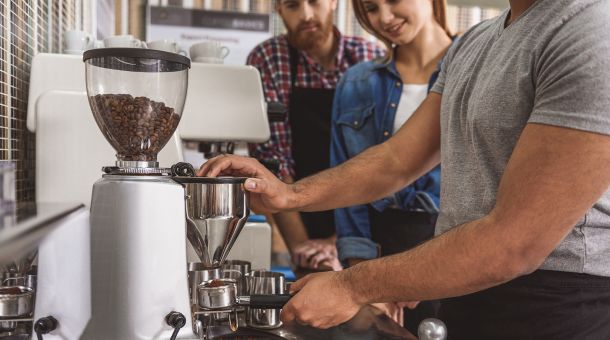Coffee is a staple beverage that is enjoyed by millions of people worldwide. Whether you’re looking to kickstart your day, stay focused during work, or simply enjoy a relaxing cup at home, brewing a perfect cup of coffee is a skill that can be easily mastered.
However, the process of brewing coffee can be intimidating, especially for beginners who may feel overwhelmed by the plethora of brewing methods and equipment available.
In this article, we’ll take you through the basics of brewing coffee, providing tips and tricks to help you brew an amazing cup with minimal effort. Whether you’re a coffee enthusiast or a newbie to the world of coffee, you’ll find valuable insights to help you make a perfect cup of coffee every time.
How to Make Coffee: A Step-by-Step Guide for Beginners

The basic method of how to make coffee involves 3 things: coffee, water, and brewing equipment. Let’s work our way through these to choose the best options.
Choosing Coffee
Coffee beans are roasted before you buy them (usually). There are 3 types of roast:
- Light – more caffeine, much lighter color, and flavor.
- Medium – slightly caramel flavor, decent mid-range option
- Dark – smoky, caramelized taste, least caffeine
The roast you choose will generally depend on the flavor you like, as the differences in caffeine are negligible. Plus, if you need more caffeine, you can always drink a second cup!
Choose a medium roast because you can go lighter or darker depending on your desired flavor.
Ready-Ground or Whole Beans?
Next, you must decide whether to buy ready-ground coffee or whole beans. If you choose the latter, you must buy a coffee grinder.
The main advantage of buying whole beans is freshness. It makes a surprising difference to the quality of your coffee’s flavor. However, ready-ground coffee is arguably more convenient because it’s always ready to use.
Coffee brewing methods :
- Drip coffee: This is perhaps the most common and simplest method of brewing coffee. It involves pouring hot water over ground coffee beans in a filter, and the water drips through the coffee and filters into a pot or carafe.
- French press: This method involves steeping coarsely ground coffee in hot water, and then pressing the coffee through a filter to separate the grounds from the liquid.
- Pour-over: This method involves slowly pouring hot water over ground coffee in a filter, allowing the water to slowly drip through the coffee and filter into a cup or carafe.
- Espresso: Espresso is a concentrated form of coffee that is made by forcing hot water through finely-ground coffee under high pressure.
- Aeropress: This is a relatively new brewing method that involves steeping ground coffee in hot water and then using a plunger to force the coffee through a filter.
Each brewing method has its unique advantages and disadvantages, and the type of coffee beans, grind size, water temperature, and brew time can all affect the final taste of the coffee. It’s up to you to experiment with different brewing methods and techniques to find the one that works best for you.
How to Make Coffee:
The basic steps to make coffee are as follows:
- Boil water: The first step is to boil water in a kettle or pot.
- Grind coffee beans: If you have whole coffee beans, grind them using a coffee grinder. For a standard 8-ounce cup, use two tablespoons of coffee beans.
- Prepare the filter: Place a coffee filter in a filter holder or a coffee maker.
- Add coffee: Add the ground coffee to the filter.
- Add water: Pour the boiled water over the coffee grounds. Make sure that all the grounds are wet.
- Brew the coffee: Allow the coffee to brew for 3-5 minutes, depending on your preference.
The specific steps and amount of coffee you need depend on your brewing method. However, a general rule is that you’ll want a heaped tablespoon for every standard cup of coffee you make.
In actual measurements, that’ll be 0.6oz. (18g) to 10 fl. oz. (300ml) of hot water. Of course, you can play around with these measurements for stronger or weaker cups and scale them up depending on how much coffee you’re making.
Common Mistakes When Making Coffee
Making coffee is generally simple: you add hot water to the ground coffee and leave it to brew. However, it’s possible to make a range of mistakes that can massively impact the flavor. Here are some of the most common and how you can avoid them.
1: Not using fresh beans:
One of the most common mistakes that people make when making coffee is using old or stale beans. Coffee beans can lose their flavor and aroma over time, and this can greatly impact the taste of the coffee.
To ensure that your coffee tastes great, make sure to use fresh beans that have been roasted within the past two weeks. You can also purchase whole beans and grind them just before brewing to ensure maximum freshness.
2: Using the wrong grind size:
Different brewing methods require different grind sizes. For example, French press coffee requires a coarse grind, while espresso requires a fine grind. Using the wrong grind size can result in over or under-extraction of the coffee, which can impact the flavor and quality of the final product. To avoid this mistake, make sure to research the appropriate grind size for your brewing method.
3: Using the wrong water temperature:
The temperature of the water used to brew coffee can greatly impact the flavor of the final product. Water that is too hot can result in a bitter and burnt taste, while water that is too cold can result in under-extraction.
The ideal temperature for brewing coffee is between 195°F and 205°F. To ensure that your coffee is brewed at the appropriate temperature, use a thermometer or a coffee maker with built-in temperature control.
4: Using too much or too little coffee:
The amount of coffee used will greatly impact the flavor of the final product. Using too much coffee can result in an overpowering and bitter taste while using too little coffee can result in a weak and under-extracted cup.
To avoid this mistake, use the appropriate amount of coffee for your brewing method and adjust it accordingly to your personal taste.
5: Not cleaning your equipment:
Over time, coffee oils and residue can build up in your equipment, and this can impact the flavor of your coffee.
To avoid this, make sure to clean your equipment regularly, including your coffee maker, grinder, and French press. You can use specialized cleaning products or simply clean with hot water and soap.
Conclusion
One of the best things about making coffee is that it can be as flexible as you want. Some methods give you a single cup of standard coffee, whereas others give you espresso-sized amounts of thick, sticky liquid. Which you choose ultimately depends on your tastes.
The bottom line is that knowing how to make coffee means mastering your preferred brewing method. Use the steps above as a starting point to find your favorite and see how in-depth you can get.
How to Make Coffee How to Make Coffee How to Make Coffee How to Make Coffee How to Make Coffee How to Make Coffee How to Make Coffee How to Make Coffee How to Make Coffee

